Menus
- Real driving machine with a retro look
- 13 HP less than the sister model
- The engine of the Kawasaki Z 900 RS runs even more silky
- Z 900 even more curvy
- Comfortable and stable
- High standard also with ABS
- The technical basis: Kawasaki Z 900
- Conclusion on the new Kawasaki Z 900 RS
- Offers for the Kawasaki Z 900 RS
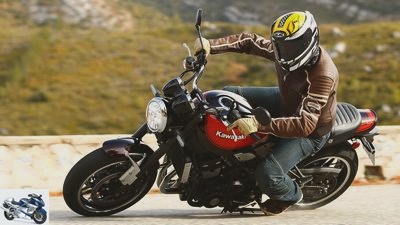
Jacek Bilski
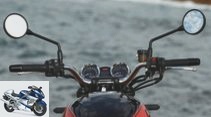
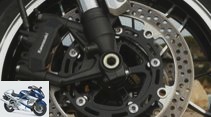
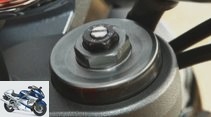
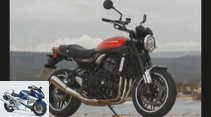
23 photos
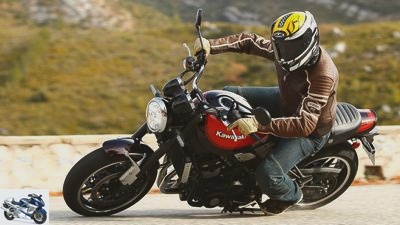
bilski-fotografie.de
1/23
Kawasaki Z 900 RS: technology from the Z 900, style based on the epoch-making Z1.
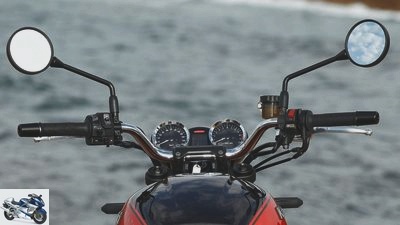
bilski-fotografie.de
2/23
Wide, high, stretched close to the driver: the moderately old-fashioned handlebars largely determine the driving experience by giving the pilot the upright, comfortable posture.
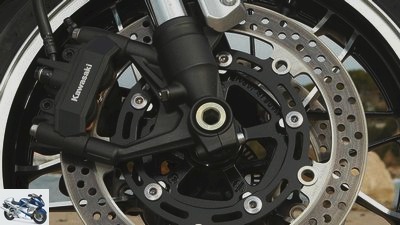
bilski-fotografie.de
3/23
Upgrade 1: radial brake calipers, plus cast aluminum wheels in a stylish spoke look.
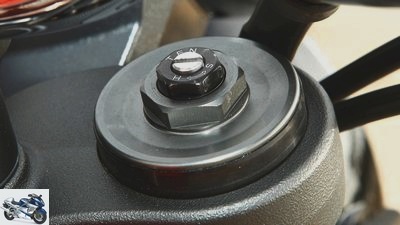
bilski-fotografie.de
4/23
Upgrade 2: spring base and rebound stage in both bars, plus compression stage on the fork base.
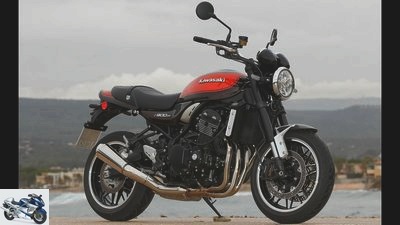
bilski-fotografie.de
5/23
In terms of style, the RS appears very confident, but modern technology has priority: USD fork, monoshock, aluminum wheels, four-in-one.
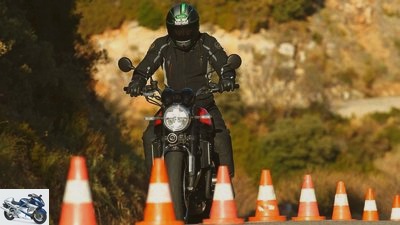
bilski-fotografie.de
6/23
Unspectacular: This is an emergency stop with a fully submerged fork. The RS is very stable on the brakes, the ABS controls fine, the rear wheel stays safely on the ground.
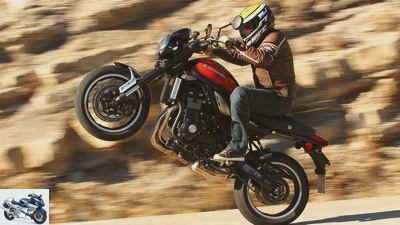
bilski-fotografie.de
7/23
From 0 to 100 in 3.5 seconds is impressive. The retro Kawa takes 16.8 seconds to reach 200.
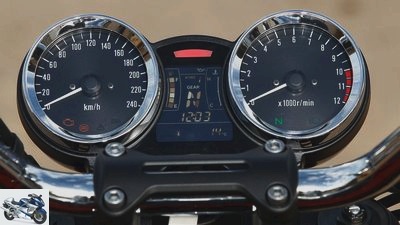
bilski-fotografie.de
8/23
All well and good: the round instruments are perfectly legible even in sunlight!
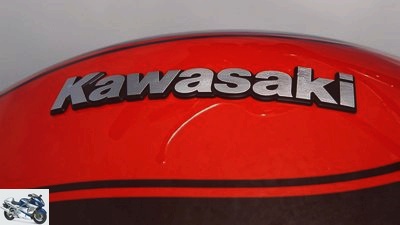
bilski-fotografie.de
9/23
An attempt to capture the spectacular metallic paint in the photograph.

bilski-fotografie.de
10/23
Upgrade 3: A radial pump improves the controllability of the brake even further.
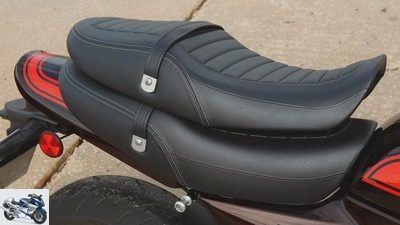
bilski-fotografie.de
11/23
Lowrider: A low accessory bench reduces the seat height. Costs 295 euros.

bilski-fotografie.de
12/23
Adjustable clutch lever: An adjustable brake lever is available anyway, but an adjustable clutch lever is also nice in this price range. The cable clutch is easy to move.

bilski-fotografie.de
13/23
Oil sight glass: Checking the oil level and color using the sight glass is so practical that we always want to refer to it at this point.
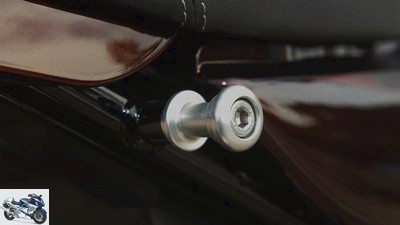
bilski-fotografie.de
14/23
Luggage hook: Not only does it look good, it can do something too. A roll of luggage can be easily lashed here without having to stretch the belt down to the passenger footrests.
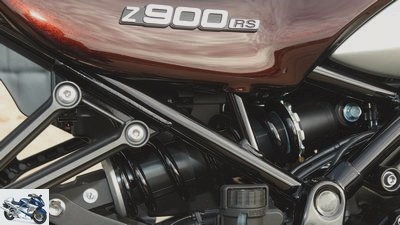
bilski-fotografie.de
15/23
Spring base: The adjusting nuts of the strut are located deep in the frame, can hardly be reached even with the right tool and are difficult to turn. In addition, the hook wrench is missing in the vehicle tool kit.
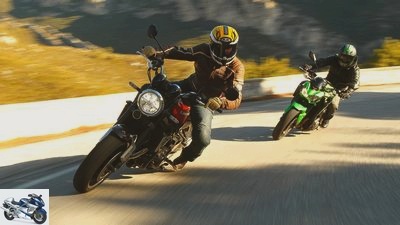
bilski-fotografie.de
16/23
Unequal sisters? Optically certainly. Both are similar in their excellent driving behavior.
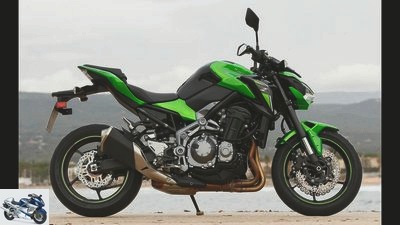
bilski-fotografie.de
17/23
The technical basis of the RS: Z 900.
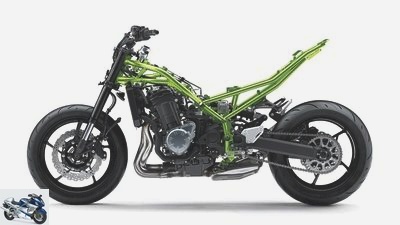
Kawasaki
18/23
Lower at the front, higher at the rear, overall more compact – the Z 900 as a sporty naked.

Kawasaki
19/23
In comparison: the RS.

bilski-fotografie.de
20/23
Kawasaki did sound design for the first time with the Z 900 RS. Low-frequency roaring when standing, always smoky bass. Not quiet but never loud either. Simply strikingly beautiful.
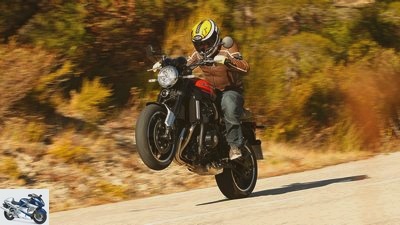
bilski-fotografie.de
21/23
The traction control, which can be switched off, also allows juicy acceleration wheelies.
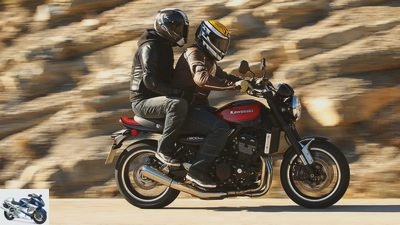
bilski-fotografie.de
22/23
Long, well-padded bench seat also offers a comfortable place for the pillion passenger.
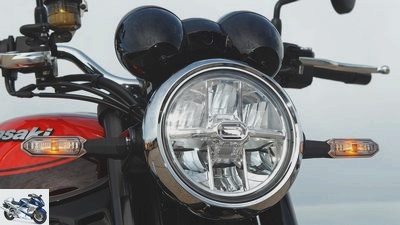
bilski-fotografie.de
23/23
It’s not just the round headlights that are really big on the Z 900 RS.
Kawasaki Z 900 RS (2018) in the test
Real driving machine with a retro look
The Kawasaki Z 900 RS is making a wave like no other motorcycle for a long time. The technology comes principally from the Z 900, the style is a nod to the epoch-making Z1. But what cracks the Kawasaki Z 900 RS in the test?
First of all, some very edifying news: The new looks in metal Kawasaki Z 900 RS looks even better than in the photos. This iconic silhouette – how the tank hugs the lattice tube, the round headlights and the wonderful analogue clocks, the high-quality, slightly tiered bench, the bold, high-swinging rear end – really big cinema. Attention also in detail: the finely sparkling stainless steel manifold, an engine block carefully cleaned of frills compared to its technology donor, the poisonous styled Z 900, the cheffig high-cranked handlebar, the rearview mirror, the elegant aluminum bracket of the front fender, the cast aluminum wheels with their dignified Spoke design and the polished rim edge, a splash of chrome here and there – everything lovingly, organically flowing into one another, classic and modern at the same time.
Buy complete article
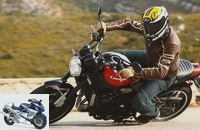
Kawasaki Z 900 RS (2018) in the test
Real driving machine with a retro look
Special paint is worth the 300 euros extra charge
Then the enormous depth of the metallic paintwork: the “Candytone Brown” shimmers, depending on the sunlight, from almost black to a warm brown to purple and to the bet with the orange sparkling accents. There is no doubt that the special paint is worth the 300 euros extra charge. Yes, the Kawasaki Z 900 RS entertains its viewer even when it is stationary, with its carefully balanced proportions it creates a mad balancing act between old elegance and new beefiness. If you like it more vividly: She is buxom like Pamela Anderson during the “Baywatch” phase. In any case, a more than successful homage to the Z1.
bilski-fotografie.de
The traction control, which can be switched off, also allows juicy acceleration wheelies.
Admittedly – proponents of pure doctrine object that their four-in-four exhaust system and stereo shock absorbers are missing for the perfect classic look. At this point, however, Kawasaki’s engineers deliberately give function priority over form. Stereo suspension struts are from the day before yesterday in terms of driving dynamics, and a four-in-four exhaust system is not only extremely expensive, but also heavy. So that is the motto of the Kawasaki Z 900 RS: It should not only look good like the old Z1, but also preserve the virtues of the new Z 900. It should be a driving machine.
13 HP less than the sister model
In view of this, the announcement that the 948 cubic in-line four-cylinder of the Kawasaki Z 900 RS has been capped at 13 HP in favor of a more powerful torque curve at the top (rated output 112 instead of 125 HP), will surely have surprised some. Because the powerful Z 900 really doesn’t lack draft. And mostly such torque-optimizing measures in the lower speed range don’t add what they take above.
bilski-fotografie.de
Kawasaki Z 900 RS: technology from the Z 900, style based on the epoch-making Z1.
The same is true of the performance diagram, in the case of the Kawasaki Z 900 RS. Nevertheless, the 948 remains a creamy aggregate even after the torque cure or performance diet. The changes are the usual: camshafts with tamer control times, lower compression (10.8 instead of 11.8 to 1), more centrifugal mass. Gear one is shorter, gear six is longer, the secondary gear ratio is two teeth longer at the rear, which is offset by the fact that the maximum speed has been reduced by around 1000 rpm. When it comes to performance, the Z 900 RS is a little behind its sister, who is taking part in this top test as a reference. Over a wide area in the middle, both press about the same force, at the bottom the RS pushes harder, but at the top the Z 900 is much more fiery. On its own, however, the RS punches roughly through the entire speed range.
The engine of the Kawasaki Z 900 RS runs even more silky
Above all, the increased flywheel mass is good for the engine, changing the character of the Inline-Four from airy turning to earthy pusher. On top of that, the overall slightly lower speed level calms the Kawasaki Z 900 RS. The engine runs even more silky, just as spontaneously, but not nervously on the gas – driving modes are never missed. The sound pressure that escapes from the silencer has a particular charm. In the case of the Z 900 RS, Kawasaki operated sound design for the first time, as the press release reports with some pride. Rightly so: low-frequency roaring when standing, always with a smoky bass full of displacement, angry at the top – not quiet, but never loud or even chubby.
markus-jahn.com
This is what the Kawasaki 900 Z1 from the 1970s looks like.
The RS is a veritable ear canal flatterer, no production motorcycle has sounded so strikingly beautiful for a long time. The clutch and transmission of the Z 900 did not require any further improvement, apart from the sensible adjustment of the gear ratio. In short, the aisles are sorted very precisely and slide buttery-soft. The servo-assisted clutch can be pulled very easily and has a useful anti-hopping function, as is the case with the Kawasaki Z 900 RS. The clutch of our test machine, however, picked very pronounced when it was cold – point deduction.
Z 900 even more curvy
The technicians made the following changes to the frame geometry: The Kawasaki Z 900 RS is higher at the front, lower at the rear, new upper triple clamps reduce the caster by six to 98 millimeters, and the wheelbase increases by 20 to 1470 millimeters. All of this, in conjunction with a higher quality Kayaba fork, which can now also be adjusted in the compression stage, is noticeable in the form of an incredibly smooth road holding. Even the Z 900 is wonderfully stable for a mid-range motorcycle, but is more curvy than the RS. The changed seating position also contributes to this. On the RS, the tall, wide handlebars that reach further back are less front-wheel oriented, but much more casual and comfortable. Which does not mean that the Z 900 RS would be sluggish – rather obedient in the best sense of the word. At 65 degrees, the steering head angle remains unchanged, and so the RS cuts a corner less directly, but angles in a sublime neutrality with very little effort. Even better than the already good Z 900.
bilski-fotografie.de
All well and good: the round instruments are perfectly legible even in sunlight!
A credit to the first tire, Dunlop’s GPR 300 (“J” specification). It has been available for a long time, but the Kawasaki Z 900 RS is the first motorcycle to have this tire ex works. A good choice and maybe THE surprise of this top test. Because while the Sportmax Qualifier from the same company as an OEM tire has already slowed down many a good machine, the GPR 300 scores across the board: short warm-up, good grip wet and dry, clear feedback, hardly any set-up moment, but above all one-a-a-kind -Handling – Chapeau, Dunlop!
Comfortable and stable
The rubber adheres so nicely that it soon reveals the Kawasaki Z 900 RS to have a somewhat limited lean angle. Factory-preloaded at the rear at zero (a lot of negative spring travel), the Retrokawa cuts its short fear nipples even at slightly more than moderate cornering speeds. To the left there is not much space left up to the boom of the side stand, as can be seen from the lead picture. Dedicated drivers are therefore strongly advised to increase the spring preload, as three to five visible threads result in a considerable increase in lean angle, without the wonderful balance of the RS being significantly impaired. Unfortunately, the spring base on the shock absorber located deep in the frame is hardly accessible and no hook wrench is included in the vehicle tool kit. The only notable faux pas that the Z 900 RS makes.
bilski-fotografie.de
Long, well-padded bench seat also offers a comfortable place for the pillion passenger.
Apart from the rear preload, no further modifications to the chassis were necessary. The fork and shock absorber worked extremely well in the factory settings (rebound stage at the front almost completely open!) In the single-digit temperature range prevailing at the time of the test. A flawless functionality of the rear shock absorber equipped with a rocker arm is already known from the Z 900. The new fork of the Kawasaki Z 900 RS, however, runs so smoothly, responds as sensitively as you can otherwise only experience with significantly more expensive material. This creates a great compromise between comfort and driving stability and is clear evidence that the considerable additional price of at least 2,600 euros compared to the Z 900 is not just invested in optics.
High standard also with ABS
Another example of this is the brake: on the fork foot there are now radially attached four-piston calipers instead of floating calipers, and on the handlebars a radially actuated pump instead of an axial one. This means that the Kawasaki Z 900 RS does not brake any harder than the Z 900, which is also powerful here, but the dosage is even more accurate and smooth. But above all, the RS is more stable on the brakes, especially with a pillion passenger, which is due to the changed weight distribution. High standard also with ABS: Here and there, the system regulates with fine intervals and safe driving – top values in the naked sector.
bilski-fotografie.de
The adjusting nuts of the shock absorber are located deep in the frame, can hardly be reached even with the right tool and can only be turned with great effort.
In addition, a two-stage traction control that can be switched off now works in the RS – and more sporty than foolproof. Even at the more conservative level two, it hardly gets in the way of heaters (good!), And at level one it even allows juicy acceleration wheelies – but also small slides on the gas. Blunt full throttle in a large lean angle à la “TC on, brains off” is therefore prohibited. What is remarkable is the lascivious ignition breaker crackling that the RS produces when it intervenes. It inspires.
Finally, with regard to the everyday use of the Z 900 RS, the following should be noted: The old-fashioned design increases the practical use considerably. The long bench is not only superbly padded, but also offers the passenger a very comfortable place with a pleasantly open knee angle. The large round mirrors offer the best overview of the game to the rear, and there are even attractive luggage hooks.
The technical basis: Kawasaki Z 900
When the model changed from the Z 800 to the Z 900, Kawasaki switched from a steel bridge frame to a tubular space frame made of the same material – and thus made the Kawasaki Z 900 RS possible in this form in the first place. In addition to a significant weight saving, this not only offers the more classic look, but can also be modified with less effort. The pipe segments were pulled closer to the center of the vehicle via the cylinder head to the steering head – this is made possible by the classic tank shape, which other representatives of the retro look sometimes struggle with.
bilski-fotografie.de
Unequal sisters? Optically certainly. Both are similar in their excellent driving behavior.
The front of the Kawasaki Z 900 RS is higher, as can be seen in the comparison. Due to modified fork bridges, the caster has also shrunk by seven from 105 to 98 millimeters. It is also easy to see that the rear frame is now much flatter, following the classic line. Further modifications compared to the Z 900: radial brake calipers and pump, waiver of fashionable wave brake discs, new wheel design, a higher-quality fork (with unchanged 120 millimeters of spring travel), less peak performance in favor of a torque-optimized design. And of course, practically all attachments change. The engine layout itself, the rear suspension strut and the swing arm have remained the same.
Conclusion on the new Kawasaki Z 900 RS
The nicest thing about the Kawasaki Z 900 RS is not its stunning exterior. The best thing about it is how it drives: it lies even richer, dampens even smoother, steers even more neutral – and loses just a touch of the absolute handiness of the Z 900. Although it leaves a lot of problems in terms of performance, the modifications to the engine make sense in terms of character. So the hefty surcharge is worth every euro in the end.
Offers for the Kawasaki Z 900 RS
Used Kawasaki Z 900 RS in Germany
So that the surcharge doesn’t hurt too much, you should take a look at the used motorcycle exchange. There you will find the Kawasaki Z900RS in top condition and very cheap: Used Kawasaki Z 900 RS in Germany
Related articles
-
Artist Top test Kawasaki ZZR 1400 The time machine Welcome in the future. The ZZR 1400 is said to be the first production bike in the world to shake 200…
-
Endurance test final balance of the Kawasaki ZX-10R
Bilski endurance test final balance sheet Kawasaki ZX-10R Too good to strip After 50,000 kilometers it is opened, looked inside and measured. So are the …
-
Comparison test Suzuki SV 650, Honda CB 650 F, Kawasaki ER-6n, Yamaha MT-07
www.bilski-fotografie.de 34 pictures www.bilski-fotografie.de 1/34 They are the hottest candidates among the middle class naked bikes ….
-
Endurance test Kawasaki ER-5 Twister
Endurance test Kawasaki ER-5 Twister Number-5 is alive Small, simple motorcycles tend to have long and exhausting lives. The long-distance test ER-5 is…
-
Honda CB 1100 RS, Kawasaki Z 900 RS and Yamaha XSR 900 in the test
bilski-fotografie.de 31 photos bilski-fotografie.de 1/31 The Honda CB 1100 RS. bilski-fotografie.de 2/31 A feast for the eyes: Visually, the Honda is…
-
Comparison test BMW S 1000 RR, Kawasaki ZX-10R and Yamaha YZF-R1M
22 images 1/22 BMW S 1000 RR, Kawasaki Ninja ZX-10R and Yamaha YZF-R1M. 2/22 Yamaha YZF-R1M. 3/22 BMW …
-
Jahn Top test Kawasaki ZX-12R ZX-12Air With its 175 hp engine, Kawasaki’s green racer bridges distances as if in flight and, if necessary, pushes the…
-
Gargolov Top test Kawasaki ZZ-R 1200 Heavy hum A sports tourer, mighty, strong, carved from the solid: the Kawasaki ZZ-R 1200. By no means perfect, but…
-
Gargolov Top test Kawasaki Z 750 In a class of its own Either no opponents or “a lot of enemy, a lot of honor”? In the past, Kawasaki’s Z 750 occupied…
-
Driving report Kawasaki Ninja 400 (2018)
Arturo Rivas 29 photos Arturo Rivas 1/29 Kawasaki has redesigned the entry-level ninja. The twin’s cubic capacity and power increased, which is now…